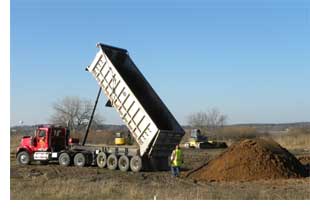Brownfields:
 Brownfield
programs are not just about restoring old buildings and cleaning up contaminated sites. These programs also provide technical assistance
and funding for tribal capacity building. This capacity building is necessary in several areas. In order to develop an efficient
Brownfield program, tribes need to hire and train staff, engage with the community, and prioritize efforts to cleanup, redevelop
and/or reuse property. Resources available to Brownfield programs allow you to determine what risks may be present in your community,
how to prevent future contamination, and provide you with strategies for developing outreach materials, writing ordinances, and
identifying other sources of assistance and funding for your community’s environmental planning.
Brownfield
programs are not just about restoring old buildings and cleaning up contaminated sites. These programs also provide technical assistance
and funding for tribal capacity building. This capacity building is necessary in several areas. In order to develop an efficient
Brownfield program, tribes need to hire and train staff, engage with the community, and prioritize efforts to cleanup, redevelop
and/or reuse property. Resources available to Brownfield programs allow you to determine what risks may be present in your community,
how to prevent future contamination, and provide you with strategies for developing outreach materials, writing ordinances, and
identifying other sources of assistance and funding for your community’s environmental planning.For examples of what tribes have used Brownfields funding and technical assistance for, go to the following link:
What can Brownfields funding be used for in tribal communities?
Brownfields are real property, the expansion, redevelopment, or reuse of which may be complicated by the presence or potential presence of a hazardous substance, pollutant, or contaminant. Cleaning up and reinvesting in these properties protects the environment, reduces blight, and takes development pressures off greenspaces and working lands. On EPA’s site, you can find information about US EPA's Brownfields Program including the Brownfields Law, Brownfields Grants, Land Revitalization Information, and more...
State and tribal response programs oversee assessment and cleanup activities at the majority of brownfields sites across the country. The depth and breadth of state and tribal response programs vary. Some focus on Comprehensive Environmental Response, Compensation, and Liability Act (CERCLA) related activities, while others are multifaceted, for example, addressing sites regulated by both CERCLA and the Resource Conservation and Recovery Act (RCRA).
The elements of a response program that a State or Tribe must include or take reasonable steps to include are:
- Timely brownfield sites inventory
- Oversight and enforcement authorities to ensure response actions will protect human health, be conducted in accordance with applicable Federal and State laws, and will be completed
- Mechanisms and resources to provide meaningful opportunities for public participation
- Mechanisms for approval of a cleanup plan
These elements are further described within the training modules developed by the Midwest Assistance Program provided here.
Training Modules:
The Midwest Assistance Program has developed CERCLA 128(a) Tribal Response Program training modules and resources for:
Chemicals of Concern:
Chemicals of concern are identified through assessments due to the variety of sites that may be considered Brownfield Sites. During the Phase I environmental site assessment, possible contamination is identified due to the parcel's historical uses. For example, solvent and petroleum contamination may be identified as possible sources of contamination if a site was historically used as a gas station or maintenance facility. Possible asbestos and heavy metal contamination may be identified as a result of a fire that destroyed an abandoned building. The Phase II site assessment includes sampling to identify levels and locations of contamination from previous activities. The completed assessments will provide the Tribe with the information needed to conduct cleanup (if necessary) and redevelopment activities.For more examples of possible contamination due to historical land uses, see Land Uses and Associated Contaminants, a document modified from Landcare Research: http://contamsites.landcareresearch.co.nz/what_is_a_contaminated_site.htm
Implementing Solutions:
Please submit your experiences (successes/challenges) and tribal-specific documents to share on our website using the attached form.Download Form
Little River Band of Ottawa Indians Case Study:
EPA Brownfields Assessment and Cleanup Grant [ms word]
Resources:
EPA 2014 Tribal Brownfields and Response [pdf]For updated versions of EPA’s State and Tribal Brownfields Publications go to:
EPA’s BF Publications [html]
EPA Region10 eligibility and contacts matrix for funding sources: EPAR10BFAssistOverviewMatrix2010.xls [xls]
Funding Guidance for State and Tribal Response Programs Fiscal Year 2012 [pdf]
Alaska Department of Environmental Conservation’s Frequently Asked Questions About Brownfields October 2007 [doc]
Websites:
Brownfields Technical Support Center (BTSC) can provide technical assistance to tribes:www.brownfieldstsc.org/
Brownfields Reauthorization issues and general information:
www.nemw.org/index.php/policy-areas/brownfields
State of Alaska Brownfield Program Resources:
www.dec.state.ak.us/spar/csp/brownfields.htm
The Assessment, Cleanup and Redevelopment Exchange System (ACRES) is an online database for Brownfields Grantees to electronically submit data directly to EPA:
www.epa.gov/brownfields/brownfields-grantee-reporting-assessment-cleanup-and-redevelopment-exchange-system-acres
The Brownfields Road Map is designed to help non-technical stakeholders understand options for site investigation and cleanup and communicate effectively with technical professionals:
www.brownfieldstsc.org/roadmap
Brownfields and Land Revitalization Laws & Statutes:
www.epa.gov/brownfields/brownfields-laws-and-regulations
Brownfields and Land Revitalization Grants and Funding:
www.epa.gov/brownfields/grant_info/index.htm
Brownfields and Land Revitalization Basic Information:
www.epa.gov/brownfields
Related Pages:
Abandoned/Unsafe Buildings and StructuresAboveground Storage Tanks
Alaska Tribal Response Program Training Modules
Burning
Coal Mining
Contaminated Sites
CERCLA
Drums
Mines
Tribal Brownfields Funding Examples
Tribal Response Program Training Modules
Resource Conservation & Recovery Act
Underground Storage Tanks
Hazardous Materials Transport
For more information, please contact:
Jennifer Williams, Alaska Program Coordinator, Sr.
Tel: 928/523-0673
Email: Jennifer.Williams@nau.edu
Tel: 928/523-0673
Email: Jennifer.Williams@nau.edu
Last updated: November 21, 2016
